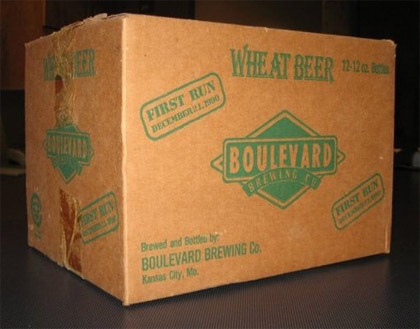
Last week a customer returned a 12-pack of Boulevard Wheat Beer that’s nearly 19 years old to the brewery.
The Pitch, a Kansas City food blog, reported:
“My office is pretty close to Boulevard and they’re a real admirable company. I just thought they might be interested in having it,” says (Eric) Henry, co-owner of the City Cement Concrete Construction Company at 65 Southwest Boulevard in Kansas City, Kansas.
He remembers buying what would have been some of the first Boulevard Wheat sold in the city at a liquor store on the corner of 43rd and State Line. It was just before Christmas — the box is stamped with the words “first run, December 21, 1990.”
He decided to store the 12-pack in his basement, keeping it dry through two moves by storing it between the floor joists above the rock foundation of his basement. As to why he never opened it, Henry can’t say exactly.
Boulevard likely will put the box on display in its tasting room. I wish they’d sneak a couple of bottles into the mix for the daily sensory evaluation of Boulevard beers. Wouldn’t you like to be a fly on the wall for that?
Five years ago I was lucky enough to be at the Duvel/Moortgat brewery in Belgium a few days after a customer had given Michael Moortgat a half crate of 20-year-old Duvel. He opened one of the bottles. The usually pale Duvel poured copper-colored and with little of the normally abundant head. Not surprisingly all of the hop character was gone and you had to hunt to find any of the typical Duvel flavors.
Anyway, there’s more history in the box pictured above than anybody would have expected in 1990. No way Boulevard founder John McDonald could have predicted that his wheat beer would turn into such a powerful flagship. In fact in the mid-90s the brewery almost dropped the beer. At the time it was filtered, but would occasionally appear cloudy because of chill haze (a temporary cloudiness that disappears at it warms) and customers feared there was something wrong with the beer. Here’s a sneak preview from Brewing With Wheat:
Boulevard’s leadership rightfully worried about the brewery’s overall reputation and considered killing the brand. Instead they returned to an earlier plan, to test selling the beer unfiltered, starting in the brewery tasting room bar. Not until Boulevard added a centrifuge was the beer bottled. Sales jumped after the Grand Street Café began serving Unfiltered Wheat with a lemon wedge. Like the Dublin Pub in Portland, the café was a place where other servers hung out and — this is starting to sound awfully familiar — the practice quickly spread across town.
“Soon every bar wanted to get that cloudy beer you serve with a lemon, and the rest is history. The cloudy appearance and uniqueness of the combination made for an easy-drinking beer that was now special, a beer with character,” (John) Bryan said. “The domestic beer drinker was transitioning into craft with this brand, and given the relative lack of Midwestern competition from other craft breweries, we were able to dominate the category and grow very quickly into the brewery we are today.”
Boulevard doesn’t sell nearly as much Unfiltered Wheat as Widmer sells Hefeweizen (popularized at the Dublin Pub about 10 years before UFW took off) and sales of both will likely look tiny compared to the new Bud Light Golden Wheat but it seems likely that when the numbers are in for 2009 that Boulevard will sell more em>Unfiltered Wheat alone (about 65 percent of its sales) than Anchor Brewing makes overall.
Looking at that box I’m pretty sure you’d blame the beer rather than the packaging.
Speaking of old beers and Anchor.. I was at my girlfriend’s old family cabin in CO this summer and stumbled across some Anchor beers, 3 Porters and 3 Liberty Ales, that we guessed to be from the mid-eighties or so. (This could be wrong, but the only date markings we found were the copyright dates on the labels, which were marked 1986.)
We chilled one of each to try, and both weren’t really palatable. The porter still had flavors reminiscent of its true form, but the Liberty not so much, and they were both vinegary in taste. A sip or two was all that we could handle.
That being said, if I came across another similar find, I wouldn’t hesitate at all to take my chances and taste that beer.
Stan,
Do you happen to know where to find sales numbers for AB products like Bud Light Golden Wheat?
Dave – I won’t see numbers on a timely basis. I think Nielsen and IRI numbers are updated regularly but I count on the stories that aggregate them a couple of times a year.
I suspect you’d get a good idea if you subscribed to Beer Business Daily.